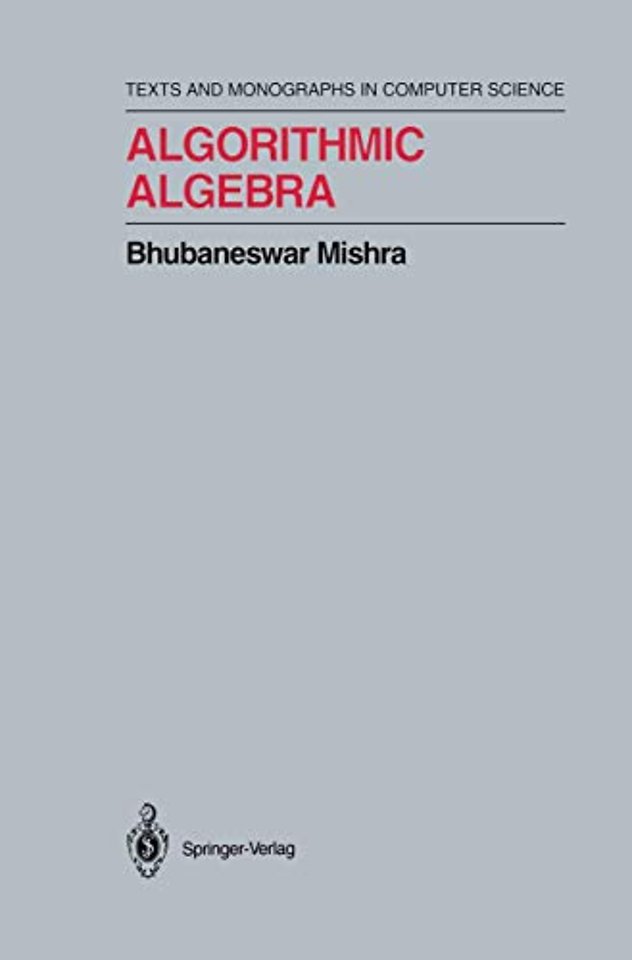Algorithmic Algebra
Gebonden Engels 1993 1e druk 9780387940908Samenvatting
'Algorithmic Algebra' studies some of the main algorithmic tools of computer algebra, covering such topics as Gröbner bases, characteristic sets, resultants and semialgebraic sets.
The main purpose of the book is to acquaint advanced undergraduate and graduate students in computer science, engineering and mathematics with the algorithmic ideas in computer algebra so that they could do research in computational algebra or understand the algorithms underlying many popular symbolic computational systems: Mathematica, Maple or Axiom, for instance. Also, researchers in robotics, solid modeling, computational geometry and automated theorem proving community may find it useful as symbolic algebraic techniques have begun to play an important role in these areas. The book, while being self-contained, is written at an advanced level and deals with the subject at an appropriate depth.
The book is accessible to computer science students with no previous algebraic training. Some mathematical readers, on the other hand, may find it interesting to see how algorithmic constructions have been used to provide fresh proofs for some classical theorems. The book also contains a large number of exercises with solutions to selected exercises, thus making it ideal as a textbook or for self-study.
Specificaties
Lezersrecensies
Inhoudsopgave
2 Algebraic Preliminaries.- 2.1 Introduction to Rings and Ideals.- 2.1.1 Rings and Ideals.- 2.1.2 Homomorphism, Contraction and Extension.- 2.1.3 Ideal Operations.- 2.2 Polynomial Rings.- 2.2.1 Dickson’s Lemma.- 2.2.2 Admissible Orderings on Power Products.- 2.3 Gröbner Bases.- 2.3.1 Gröbner Bases in K[x1, x2,...,xn].- 2.3.2 Hilbert’s Basis Theorem.- 2.3.3 Finite Gröbner Bases.- 2.4 Modules and Syzygies.- 2.5 S-Polynomials.- Problems.- Solutions to Selected Problems.- Bibliographic Notes.
3 Computational Ideal Theory.- 3.1 Introduction.- 3.2 Strongly Computable Ring.- 3.2.1 Example: Computable Field.- 3.2.2 Example: Ring of Integers.- 3.3 Head Reductions and Gröbner Bases.- 3.3.1 Algorithm to Compute Head Reduction.- 3.3.2 Algorithm to Compute Gröbner Bases.- 3.4 Detachability Computation.- 3.4.1 Expressing with the Gröbner Basis.- 3.4.2 Detachability.- 3.5 Syzygy Computation.- 3.5.1 Syzygy of a Gröbner Basis: Special Case.- 3.5.2 Syzygy of a Set: General Case.- 3.6 Hilbert’s Basis Theorem: Revisited.- 3.7 Applications of Gröbner Bases Algorithms.- 3.7.1 Membership.- 3.7.2 Congruence, Subideal and Ideal Equality.- 3.7.3 Sum and Product.- 3.7.4 Intersection.- 3.7.5 Quotient.- Problems.- Solutions to Selected Problems.- Bibliographic Notes.
4 Solving Systems of Polynomial Equations.- 4.1 Introduction.- 4.2 Triangular Set.- 4.3 Some Algebraic Geometry.- 4.3.1 Dimension of an Ideal.- 4.3.2 Solvability: Hilbert’s Nullstellensatz.- 4.3.3 Finite Solvability.- 4.4 Finding the Zeros.- Problems.- Solutions to Selected Problems.- Bibliographic Notes.
5 Characteristic Sets.- 5.1 Introduction.- 5.2 Pseudodivision and Successive Pseudodivision.- 5.3 Characteristic Sets.- 5.4 Properties of Characteristic Sets.- 5.5 Wu-Ritt Process.- 5.6 Computation.- 5.7 Geometric Theorem Proving.- Problems.- Solutions to Selected Problems.- Bibliographic Notes.
6 An Algebraic Interlude.- 6.1 Introduction.- 6.2 Unique Factorization Domain.- 6.3 Principal Ideal Domain.- 6.4 Euclidean Domain.- 6.5 Gauss Lemma.- 6.6 Strongly Computable Euclidean Domains.- Problems.- Solutions to Selected Problems.- Bibliographic Notes.
7 Resultants and Subresultants.- 7.1 Introduction.- 7.2 Resultants.- 7.3 Homomorphisms and Resultants.- 7.3.1 Evaluation Homomorphism.- 7.4 Repeated Factors in Polynomials and Discriminants.- 7.5 Determinant Polynomial.- 7.5.1 Pseudodivision: Revisited.- 7.5.2 Homomorphism and Pseudoremainder.- 7.6 Polynomial Remainder Sequences.- 7.7 Subresultants.- 7.7.1 Subresultants and Common Divisors.- 7.8 Homomorphisms and Subresultants.- 7.9 Subresultant Chain.- 7.10 Subresultant Chain Theorem.- 7.10.1 Habicht’s Theorem.- 7.10.2 Evaluation Homomorphisms.- 7.10.3 Subresultant Chain Theorem.- Problems.- Solutions to Selected Problems.- Bibliographic Notes.
8 Real Algebra.- 8.1 Introduction.- 8.2 Real Closed Fields.- 8.3 Bounds on the Roots.- 8.4 Sturm’s Theorem.- 8.5 Real Algebraic Numbers.- 8.5.1 Real Algebraic Number Field.- 8.5.2 Root Separation, Thorn’s Lemma and Representation.- 8.6 Real Geometry.- 8.6.1 Real Algebraic Sets.- 8.6.2 Delineability.- 8.6.3 Tarski-Seidenberg Theorem.- 8.6.4 Representation and Decomposition of Semialgebraic Sets.- 8.6.5 Cylindrical Algebraic Decomposition.- 8.6.6 Tarski Geometry.- Problems.- Solutions to Selected Problems.- Bibliographic Notes.
Appendix
A: Matrix Algebra.
A.1 Matrices.
A.2 Determinant.
A.3 Linear Equations.
Anderen die dit boek kochten, kochten ook
Rubrieken
- advisering
- algemeen management
- coaching en trainen
- communicatie en media
- economie
- financieel management
- inkoop en logistiek
- internet en social media
- it-management / ict
- juridisch
- leiderschap
- marketing
- mens en maatschappij
- non-profit
- ondernemen
- organisatiekunde
- personal finance
- personeelsmanagement
- persoonlijke effectiviteit
- projectmanagement
- psychologie
- reclame en verkoop
- strategisch management
- verandermanagement
- werk en loopbaan







